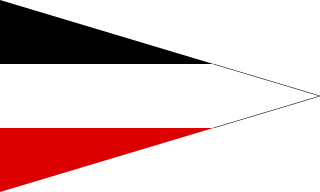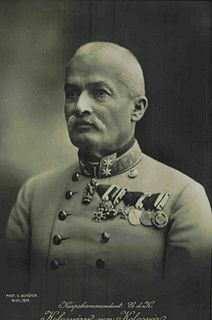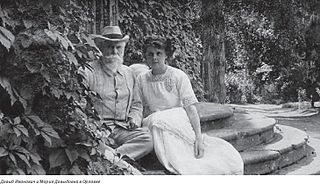
The Gorlice–Tarnów Offensive during World War I was initially conceived as a minor German offensive to relieve Russian pressure on the Austro-Hungarians to their south on the Eastern Front, but resulted in the Central Powers' chief offensive effort of 1915, causing the total collapse of the Russian lines and their retreat far into Russia. The continued series of actions lasted the majority of the campaigning season for 1915, starting in early May and only ending due to bad weather in October.

The Third Army was originally established in the Balkans and later defended the northeastern provinces of the Ottoman Empire. Its initial headquarters was at Salonica, where it formed the core of the military forces that supported the Young Turk Revolution of 1908. Many of its officers who participated in the Revolution, including Enver Pasha and Mustafa Kemal Atatürk, rose to fame and power.

The Guards Cavalry Division (Garde-Kavallerie-Division) was a unit of the German army that was stationed in Berlin. The division was a part of the Guards Corps (Gardekorps).
The 4th Ersatz Division was a unit of the German Army, in World War I. The division was formed on mobilization of the German Army in August 1914. The division was disbanded in 1919, during the demobilization of the German Army after World War I.

The Duke of Lancaster's Own Yeomanry was a British Army regiment that existed from 1798 to 1992. The regiment sent mounted infantry for service in the Second Boer War as the Imperial Yeomanry, between 1900 and 1902, and also saw action during the First and Second World Wars. Its lineage is maintained by B Squadron, the Queen's Own Yeomanry.
The 3rd Cavalry Division was a division of the British Army in the First World War. It was formed at Ludgershall, Wiltshire England in September 1914 under the command of Major-General the Hon. Julian Byng. The division moved to Belgium in the first week of October 1914, landing at Ostend, although its third Brigade was only formed once there. During the war the division took part in most of the major actions where cavalry were used as a mounted mobile force, and also many where the troops were dismounted and effectively served as infantry.

Dezső Kolossváry de Kolosvár was a Hungarian military officer in the Austro-Hungarian service and (briefly) a politician.
The 2nd Guards Cavalry Division was a Guards light cavalry division of the Imperial Russian Army.

The Bavarian Cavalry Division was a unit of the Royal Bavarian Army, part of the German Army, in World War I. The division was formed on the mobilization of the German Army in August 1914. The division was disbanded in 1919, during the demobilization of the German Army after World War I. The division was raised and recruited in Bavaria.
The history of the German Cavalry in World War I is one of an arm in decline.

The Nottinghamshire and Derbyshire Mounted Brigade was a yeomanry brigade of the British Army, formed as part of the Territorial Force in 1908.

Walter Francis Chisholm Waddington was a French cavalry officer and general. Born in Dublin, Ireland to a British Army officer, he followed his father to France and enlisted in the cavalry. Commissioned within five years, he saw service in Madagascar and was made an officer of the Legion of Honour before being promoted to the rank of général de brigade. Waddington had command of the French 12th Dragoon Brigade in the Occupation of the Rhineland following the First World War, and died there at Mainz on 23 June 1920.
The 12th Infantry Division was an infantry formation of the Russian Imperial Army that existed in various formations from the early 19th century until the end of World War I and the Russian Revolution. The division was based in Lutsk in the years leading up to 1914. It fought in World War I and was demobilized in 1918.
The 4th Cavalry Division was a cavalry formation of the Russian Imperial Army.
The 6th Cavalry Division was a cavalry formation of the Russian Imperial Army.
The 7th Cavalry Division was a cavalry formation of the Russian Imperial Army.
The 14th Cavalry Division was a cavalry formation of the Russian Imperial Army.
The Caucasus Cavalry Division was a cavalry formation of the Russian Imperial Army.
The 1st Guards Corps was a corps-level command in the Russian Imperial Army that existed in the decades leading up to and during World War I. Stationed in St Petersburg, it included some of the oldest and best known regiments of the Emperor of All Russia's Imperial Guard.
The 16th Cavalry Division was a cavalry formation of the Russian Imperial Army, formed from the 2nd and 3rd Separate Cavalry Brigades.











